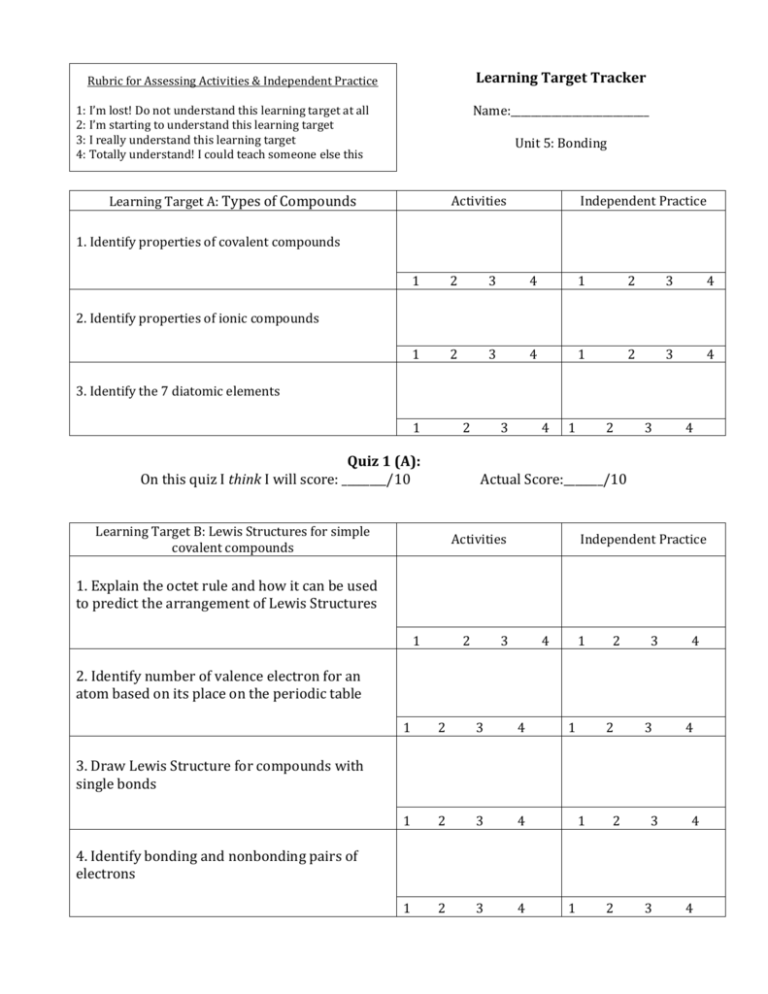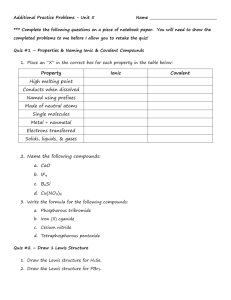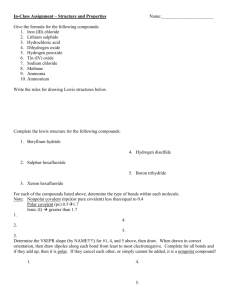Rubric for Assessing Activities & Independent Practice 1: I'm lost! Do
advertisement

Learning Target Tracker Rubric for Assessing Activities & Independent Practice Name:___________________________ 1: I’m lost! Do not understand this learning target at all 2: I’m starting to understand this learning target 3: I really understand this learning target 4: Totally understand! I could teach someone else this Unit 5: Bonding Learning Target A: Types of Compounds Activities Independent Practice 1. Identify properties of covalent compounds 1 2 3 4 1 2 3 4 1 2 3 4 1 2 3 4 2. Identify properties of ionic compounds 3. Identify the 7 diatomic elements 1 2 Quiz 1 (A): On this quiz I think I will score: ________/10 3 4 1 2 3 4 Actual Score:_______/10 Learning Target B: Lewis Structures for simple covalent compounds Activities Independent Practice 1. Explain the octet rule and how it can be used to predict the arrangement of Lewis Structures 1 2 3 4 1 2 3 4 2. Identify number of valence electron for an atom based on its place on the periodic table 1 2 3 4 1 2 3 4 1 2 3 4 1 2 3 4 3. Draw Lewis Structure for compounds with single bonds 1 2 3 4 4. Identify bonding and nonbonding pairs of electrons 1 2 3 4 Quiz 2 (B): On this quiz I think I will score: ________/10 Actual Score:_______/10 Learning Target C: Draw Lewis Structures for Complex Covalent Compounds Activities Independent Practice 1. Draw Lewis Structures for compounds with double and triple bonds 1 2 3 4 1 2 3 4 1 2 3 4 2. Predict type of bonds that will form based on total number of valence electrons 1 2 3 4 Quiz 3 (C): On this quiz I think I will score: ________/10 Actual Score:_______/10 Learning Target D: Draw Lewis Structures for polyatomic ion Activities Independent Practice 1. Describe resonance structures 1 2 3 4 1 2 3 4 2. Draw resonance structures for polyatomic ions 1 2 Learning Target E: VSEPR 3 4 1 Activities 2 3 4 Independent Practice 1. Predict molecular geometry using a Lewis Structure, Bonding, and Nonbonding pairs of electrons 1 2 3 4 1 2 3 4 2. Identify the following molecular geometries and their bond angles; linear, bent, trigonal planar, trigonal pyramidal, tetrahedral 1 2 Learning Target F: Polarity of Covalent Bonds 3 4 1 Activities 2 3 4 Independent Practice 1. Predict polarity of covalent molecules using Lewis Structures, molecular models and VSEPR 1 2 3 4 1 2 3 4 2. Calculate electronegativity difference for a molecule or a compound 1 2 3 4 1 2 3 4 1 2 3 4 1 2 3 4 3. Predict polarity/ionic character based on electronegativity difference 1 2 3 4 4. Discuss relative strength of bonds (ionic, polar covalent, covalent) Learning Target G: Intermolecular Forces 1 Activities 2 3 4 Independent Practice 1. Predict the type of intermolecular forces that will occur in a substance based on the bonding of its molecules 1 2 3 4 1 2 3 4 2. Rank the strength of intermolecular forces 1 2 3 4 1 2 3 4 1 2 3 4 3. Relate the presence of intermolecular forces to the state of matter and properties of a substance 1 2 3 4 Unit Reflection: answer the following questions in complete sentences How do you think you will do on the exam? What learning targets do you feel most prepared for? What learning targets do you need to spend more time on? Unit Exam (A-G): On this exam I think I will score : _______/50 Actual Score:_________/50




